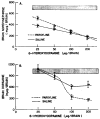Effect of 6-hydroxydopamine on brain norepinephrine and dopamine evidence for selective degeneration of catecholamine neurons
- PMID: 5456173
- PMCID: PMC3055658
Effect of 6-hydroxydopamine on brain norepinephrine and dopamine evidence for selective degeneration of catecholamine neurons
Abstract
After the intracisternal administration of 6-hydroxydopamine, brain levels of norepinephrine were reduced significantly with or without pargyline pretreatment. Depletion of dopamine in the central nervous system was found to be enhanced markedly by pargyline administration at higher dose levels of 6-hydroxydopamine. Brain serotonin concentrations were not altered. The effects of 6-hydroxydopamine were long-lasting with the depletion of brain amines persisting at 78 days. After norepinephrine-H3 intracisternally to animals treated with 6-hydroxydopamine, labeled norepinephrine uptake was diminished with a corresponding reduction of deaminated catechols and a marked increased in methylated amines. Tyrosine hydroxylase activity was found to be reduced in brainstem, caudate nucleus and whole brain in 6-hydroxydopamine-treated animals. Conversion of tyrosine-H3 to labeled norepinephrine and dopamine was also markedly diminished. The results support the view that 6-hydroxydopamine produces a “central sympathectomy” when introduced into cerebrospinal fluid.
Figures




References
-
- Anagnoste B, Backstbom T, Goldstein M. The effect of 6-hydroxydopamine (6-OH-DA) on catecholamine biosynthesis in the brain of rats. Pharmacologist. 1969;11:274.
-
- Anton AH, Satre DF. A study of the factors affecting the aluminum oxide-trihydroxyindole procedure for the analysis of catecholamines. J Pharmacol Exp Ther. 1962;138:360–375. - PubMed
-
- Anton AH, Saybe DF. The distribution of dopamine and dopa in various animals and a method for their determination in diverse biological material. J Pharmacol Exp Ther. 1964;145:326–336. - PubMed
-
- Bein HJ. Zur Pharmakologie des Reserpin, eines neuen Alkaloids aus Rauwolfia serpentina Benth. Experientia (Basel) 1953;9:107–110. - PubMed
-
- Bloom FE, Algebi S, Geoppetti A, Revuetta A, Costa E. Lesions of central norepinephrine terminals with 6-OH-dopamine: Biochemistry and fine structure. Science (Washington) 1969;166:1284–1286. - PubMed
MeSH terms
Substances
Grants and funding
LinkOut - more resources
Full Text Sources
